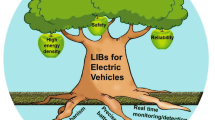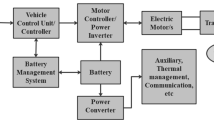Abstract
Metal-oxide surge arresters (MOSAs) play an important role in preventing outage situations and thus in preserving the reliability of electric power system. So far, many MOSA monitoring methods have been developed. These methods propose different indicators that are more or less reliable in MOSA monitoring and diagnostics. Another important aspect of these indicators is that each one of them can be determined with a certain estimation error. None of the indicators has been proved to be supreme. Nevertheless, under different conditions, the reliability of these indicators may vary. This paper presents an analysis methodology for reliability of MOSA indicators and proposes a fuzzy logic expert system that overcomes the problem of decision-making in the case when more than one indicator is available. The analysis and verification are done by computer simulations.









Similar content being viewed by others
References
Hinrichsen V (1997) Monitoring of high voltage metal oxide surge arresters. Paper presented at VI Jornadas Internacionales de Aislamiento Eléctrico Bilbao
Heinrich C, Hinrichsen V (2001) Diagnostics and monitoring of metal-oxide surge arresters in high-voltage networks-comparison of existing and newly developed procedures. IEEE Trans Power Deliv 16(1):138–143
Haddad A, Fuentes Rosado J, German DM, Waters RT (1990) Equivalent circuit for surge arrester elements at power frequency voltages. In: 25th universities power engineering conference (UPEC), vol 1, pp 361–364, Aberdeen (Scotland)
Spellman CA, Haddad A (1997) A technique for on-line monitoring of ZnO surge arrester. In: 10th international symposium on high voltage engineering (ISH), pp 151–154, Montreal (Canada)
Xu Z, Zhao L, Ding A, Lü F (2013) A current orthogonality method to extract resistive leakage current of MOSA. IEEE Trans Power Deliv 28(1):93–101
Naidu SR, Srivastava KD (1987) The validity of circuits for measuring the resistive leakage current of zinc oxide arresters
Shirakawa S et al (1988) Maintenance of surge arrester by a portable arrester leakage current detector. IEEE Trans Power Deliv 3(3):998–1003
De Souza RT, Da Costa EG, Naidu SR, Maia MJA (2004) A virtual bridge to compute the resistive leakage current waveform in ZnO surge arresters. In: 2004 IEEUPES transmission 8 distribution conference 8 exposition: latin America
Zhu H, Raghuveer MR (2001) Influence of representation model and voltage harmonics on metal oxide surge arrester diagnostics. IEEE Trans Power Deliv 16(4):599–603
Yongqiang W, Fangcheng L (2003) Influence of power system’s harmonic voltage on leakage current of MOA. In: Asia-pacific conference on environmental electromagnetics, Hangzhou, China, 2003
Novizon A-MZ, Nouruddeen B, Aulia (2011) Condition monitoring of zinc oxide surge arresters. In: Practical applications and solutions using LabVIEW™ software. InTech
Lindquist J, Stenstrom L, Schei A, Hansen B (1990) New method for measurement of the resistive leakage currents of metal-oxide surge arresters in service. IEEE Trans Power Deliv 5(4):1811–1822
Hui G, Xianfeng T, Zhengwei C, Fang Yu (2014) Application Kohonen neural network to MOA fault diagnosis. Appl Mech Mater 568–570:874–878
Novizon Y, Zulkurnain A-M (2014) Correlation between third harmonic leakage current and thermography image of zinc oxide surge arresters for fault monitoring using artificial neural network. Appl Mech Mater 554:598–602
Lira GRS, Costa EG, Ferreira TV (2014) Metal-oxide surge arrester monitoring and diagnosis by self-organizing maps. Electr Power Syst Res 108:315–321
Dobric G, Stojanovic Z, Stojkovic Z (2015) The application of genetic algorithm in diagnostics of metal-oxide surge arrester. Electr Power Syst Res 119:76–82
Khodsuz M, Mirzaie M (2015) Monitoring and identification of metal–oxide surge arrester conditions using multi-layer support vector machine. IET Gener Transm Distrib 9(16):2501–2508
Dobric G, Stojanovic Z, Stojkovic Z (2016) MOSA monitoring using unsynchronised measurements of voltage and leakage current. In: Mediterranean conference on power generation, transmission, distribution and energy conversion (MedPower 2016)
Stojanovic Z, Stojkovic Z (2013) Evaluation of MOSA condition using leakage current method. Electr Power Energy Syst 52:87–95
Dobric G (2016) Monitoring and diagnostics of metal-oxide surge arresters based on the analysis of leakage current under continuous operating voltage. Doctoral dissertation, University of Belgrade, School of Electrical Engineering
ABB Switzerland Ltd. (2011) Overvoltage protection: metal oxide surge arresters in medium voltage systems. ABB Switzerland Ltd., Wettingen
Tominaga S, Shibuya Y, Fujiwara Y, Imataki M, Nitta T (1980) Stability and long term degradation of metal oxide surge arresters. IEEE Trans Power Appar Syst PAS-99(4):1548–1556
Raju K, Prasad V (2018) Successful turning on of MOSAs under very fast transients. IET Gener Transm Distrib 12(16):3852–3861
Zhao T, Li Q, Qia J (2005) Investigation on digital algorithm for on- line monitoring and diagnostics of metal oxide surge arrester based on an accurate model. IEEE Trans Power Deliv 20(2):751–756
Žarković, M (2018) Monitoring and diagnostics of substation based on fuzzy model of high voltage equipment condition. Ph.D. dissertation, Dept., Power systems. Srb., Belgrade Univ., Belgrade. Serbia
Žarković M, Stojković Z (2015) Fuzzy logic and artificial neural network based thermography approach for monitoring of high voltage equipment. Int J Electr Eng Educ 52(1):81–96
Žarković M, Stojković Z (2015) Artificial intelligence based thermographic approach for high voltage substations risk assessment. IET Gener Transm Distrib 9(14):1935–1945
Žarković M, Stojković Z (2017) Analysis of artificial intelligence expert systems for power transformer condition monitoring and diagnostics. Electr Power Syst Res 149:125–136
Dobric G, Stojkovic Z, Stojanovic Z (2020) Experimental verification of monitoring techniques for metal-oxide surge arrester. IET Gener Transm Distrib 14(6):1021–1030
Acknowledgements
The authors thank the Ministry of Science and Technological Development of the Republic of Serbia which, within the framework of Project III 42009 ‘Smart grid’, made this work possible.
Author information
Authors and Affiliations
Corresponding author
Additional information
Publisher's Note
Springer Nature remains neutral with regard to jurisdictional claims in published maps and institutional affiliations.
Rights and permissions
About this article
Cite this article
Dobrić, G., Žarković, M. Fuzzy expert system for metal-oxide surge arrester condition monitoring. Electr Eng 103, 91–101 (2021). https://doi.org/10.1007/s00202-020-01061-z
Received:
Accepted:
Published:
Issue Date:
DOI: https://doi.org/10.1007/s00202-020-01061-z




